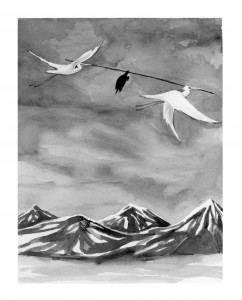Marvelous Migration

Originally appears in the Spring 2014 issue
EVERY YEAR , the American Golden Plover flies more than 20,000 miles (32,000 km) round-trip between its summer breeding grounds in the Arctic and where it overwinters in southern South America. At times it can reach airspeeds of up to 100 miles per hour (160 kph), staying aloft for more than 3,000 miles (4,800 km) at a stretch. The Arctic Tern migrates a similar round-trip distance from the Arctic to southern wintering grounds in the Antarctic Ocean. In the natural world, where it is critical to use resources wisely and avoid danger in order to survive, what would drive some birds to deplete their stores of energy and face the hazards encountered when migrating across the vast expanse of oceans and continents?
For thousands of years, bird migration has inspired a sense of wonder and awe. Before the advent of science, the mysteries of avian seasonal movements were explained in folklore that was often anchored in a curious logic. Some believed the bird species that disappeared for the winter retired to caves and trees or hibernated in the mud like turtles. Large birds, some said, carried small birds on their backs to warmer climes. Among the more fanciful beliefs: birds that disappeared during the cold season simply transformed into another species that hung around for the winter, then changed back in the springtime.
Folklore and science don’t always mesh, but stories engage children’s imaginations and enhance their understanding of how oral tradition and literature filter our world through different eyes than science. This article introduces bird migration through the Tibetan story of “The Tortoise & the Egrets” (see pages 22-23) and follows with discussion information, study questions and activities (see below) to explore the natural science and biology of bird migration.
To view the photo-rich magazine version, click here.
If you are not already a subscriber, please subscribe to read the full article
Michael J. Caduto is the author of 18 books, including Riparia’s River, Catch the Wind, Harness the Sun, and (with Joseph Bruchac) the Keepers of the Earth® series. He recently released his premier storytelling CDs: The Rainbow Garden (ages 5-10) and The Wisdom of Nature (ages 11 and up). Michael offers many programs, performances and workshops through his website: www.p-e-a-c-e.net.
The story and illustration for The Tortoise & the Egrets are used with permission from pp. 58-60 of Earth Tales from Around the World by Michael J. Caduto, illustrated ©1997 by Adelaide Tyrol (Fulcrum Publishing: Golden Colorado). Text in the Discussion, Questions and Activities sections adapted with permission from pages 158-162 of Keepers of the Earth: Native American Stories and Environmental Activities for Children (1988), and from page 146 of Keepers of the Animals: Native American Stories and Wildlife Activities for Children (1991), by Michael J. Caduto and Joseph Bruchac (Fulcrum Publishing: Golden, Colorado), with illustrations by Carol Wood.
Leave a Reply
You must be logged in to post a comment.





